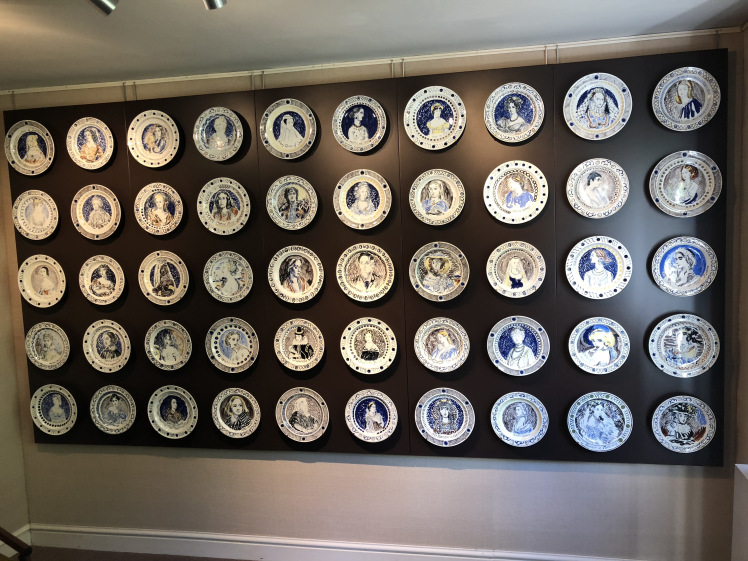
I wonder if they ever ate from them. The man from the gallery chuckled at the thought. ‘You’d be tempted wouldn’t you,’ he said. ‘Even if it were just a slice of cake.’
There’s no evidence that cake or any food has ever been served on these plates although they were apparently brought out from time to time to show guests at dinner parties. Very few people have seen them for more than eighty years. Until now. The Famous Women Dinner Service can now be seen in its entirety for the first time. And it’s quite a thing to see.
The service comprises fifty Wedgewood plates individually painted by Vanessa Bell and Duncan Grant between 1932 and 1934. There are forty-nine images of well-known women from history, literature or who were contemporaries of the artists along with fictional or mythic characters. Forty-nine because one of them features a man: Bell’s portrait of Duncan Grant with his tie and short-back-and-sides sits alone, the token male amongst so many women.
At Piano Nobile in London, they’re arranged on a wall at the back of the gallery in five rows of ten. They look remarkable individually but taken together they are breathtaking. Far from uniform - some plates are slightly smaller than others - nevertheless they show in their execution a vision, a way of seeing life and lives that gives the whole a unity of purpose. The plates retain much of the whiteness of the blanks they once were; the rims decorated with Bell and Grant patterns and doodles familiar from their decorative work from Omega onwards; the colours are blues, browns and greys with the odd shock of bright yellow.
As for the women who look out from the plates: what a varied collection! Queens such as Elizabeth, Victoria, Mary and Marie Antoinette sit alongside names from history like the Queen of Sheba, Helen of Troy and Cleopatra, theatrical figures such as Ellen Terry and writers including Bell’s sister Virgina Woolf, Charlotte Brontë, George Eliot, Elizabeth Barrett Browning and Sappho. There are surprises too. Pocahontas. Greta Garbo looking unmistakably modern. And with her bright blonde hair, a beauty queen known only as ‘Miss 1933.’
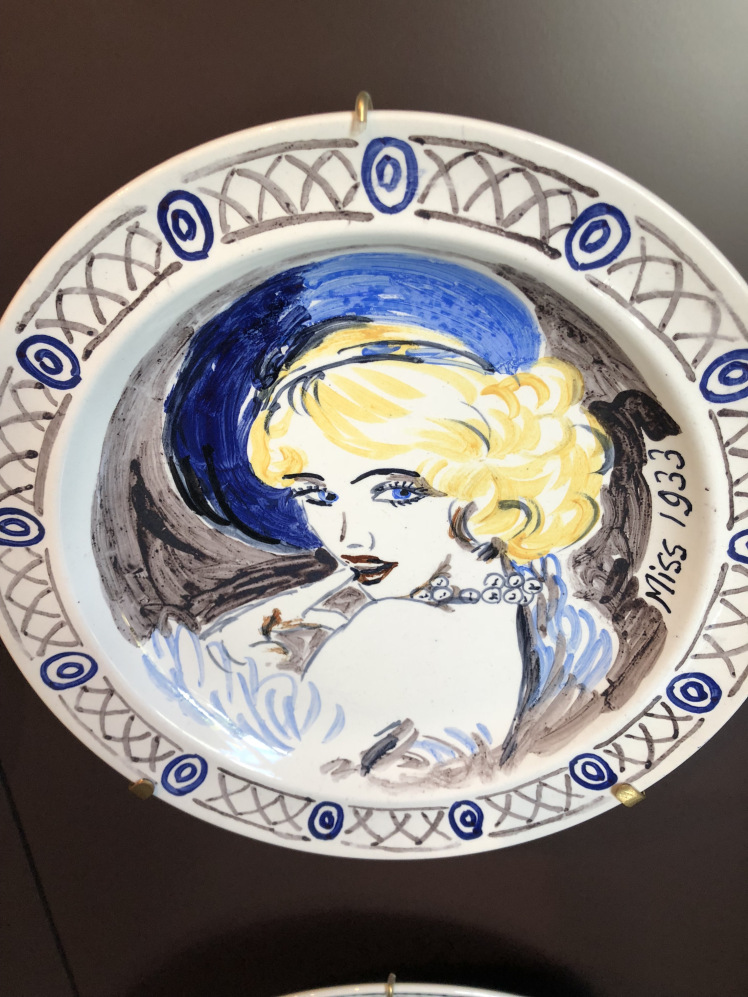
The portraits are serious, playful, funny and eclectic, perhaps Bell and Grant’s attempt to answer the question who would you invite to your fantasy dinner party, answering it literally by putting them on a dinner service. It’s not clear how the two set about selecting candidates but there’s evidence that Virginia Woolf had a big say over the writers chosen for the final fifty.
They may have been answering their own question but it seems they weren’t quite answering the specific request that had been put to them. The service was created in response to a commission by Jane Clark and her husband, the art historian Kenneth Clark. What they received wasn’t quite ‘the gay cascade of decorative art’ that they thought they’d ordered, nor was it quite the dinner service of large and small plates, side plates, cups, saucers, dishes, pots and jugs they expected.
Instead as Dr Hana Leaper, writes in her critical introduction to the collection,
Expecting luxurious fine dining ware, they instead received the ‘Famous Women’ set of fifty portrait plates, a provocative and humorous work of art that challenged both the standard orientation of history and the way in which it is recorded, as well as consolidating a call for social change, beginning in the domestic realm.
Now that the service is on public display for the first time, that’s exactly what you still get when you look at it: a different slant on history and the 1930s contemporary world from two of the most original and most imaginative creative spirits of that time. A parade of interesting and interested women, pivotal in their different ways and times. It’s an approach that puts women at the centre of the story and does so without apology, aware of the radical nature of taking that approach but carried out with a sense of fun. It’s acutely relevant in this year which marks 100 years since some women were able to vote for the first time. In 1934 it must have seemed visionary.
Incidentally Leaper, who has spent a great deal of time researching the production of the plates and the sources for the images, has put together this excellent free online catalogue of the dinner service which you can read here.
After the death of Lord Clark’s second wife, the service was sold and has remained in private ownership ever since. The Charleston Trust, which operates Bell and Grant’s farmhouse home as a popular museum of their art and work, is hoping to secure it and put it on permanent public display. You can read more here: I hope the bid succeeds. Charleston is a unique place, still fizzing with the art, ideas and stories that Bell and her family set in motion there so many decades ago.
For now you can see the dinner service at Piano Nobile in Holland Park in London alongside other works by the two artists. It’s a beautiful gallery, small and stylish, owned and run by Dr Robert Travers and a small team which combines enthusiasm and expertise. 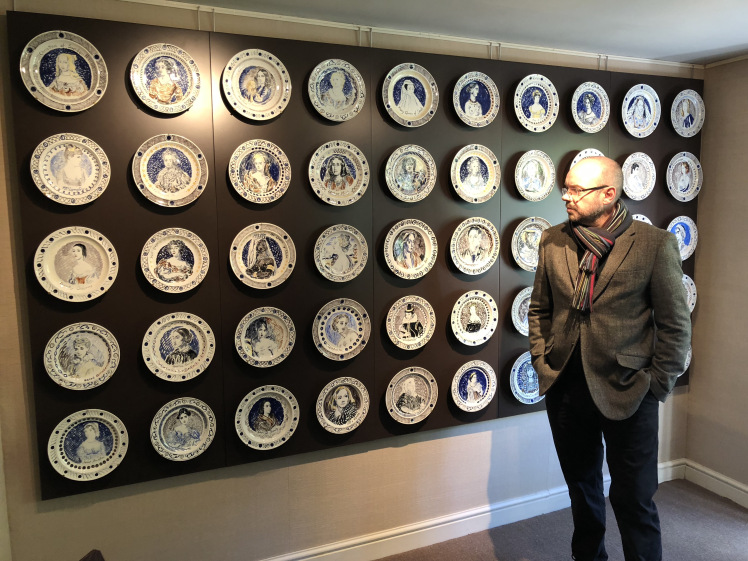
At the exhibition’s opening, the gallery was crammed with Bloomsbury connoisseurs and art experts, fans as well as leading lights of the London art scene including family members such as the slight and polite lady whose lace gloved-hand I shook and who introduced herself as Henrietta. Only later did I realise she was Vanessa and Duncan’s granddaughter. I can’t remember when I’ve been in a room so full of people who knew so much about the works we were standing with cheek by jowl, nor who had such direct links to them. People smiled at each other as we held onto champagne flutes and picked our way between the tiny spaces left to us, trying not to knock over vases (which it was a relief to see had been secured to their stands with specialist clips) or bump into precious panels.
So close to them that you can see how Duncan Grant manipulated colour: it’s swirling and bright in his restful portrait of a sleeping David Garnett from 1915; sinister and dark in the exaggerated bodies of a juggler and tightrope walker, muted and brown in ‘Tents’ on loan here from Bryan Ferry’s collection.
For Bloomsbury buffs, Lytton Strachey is here in the basement in Grant’s famous painting of him, reading as always, his long fingers curled around the book, its orange cover matching the colour of his distinctive long beard.
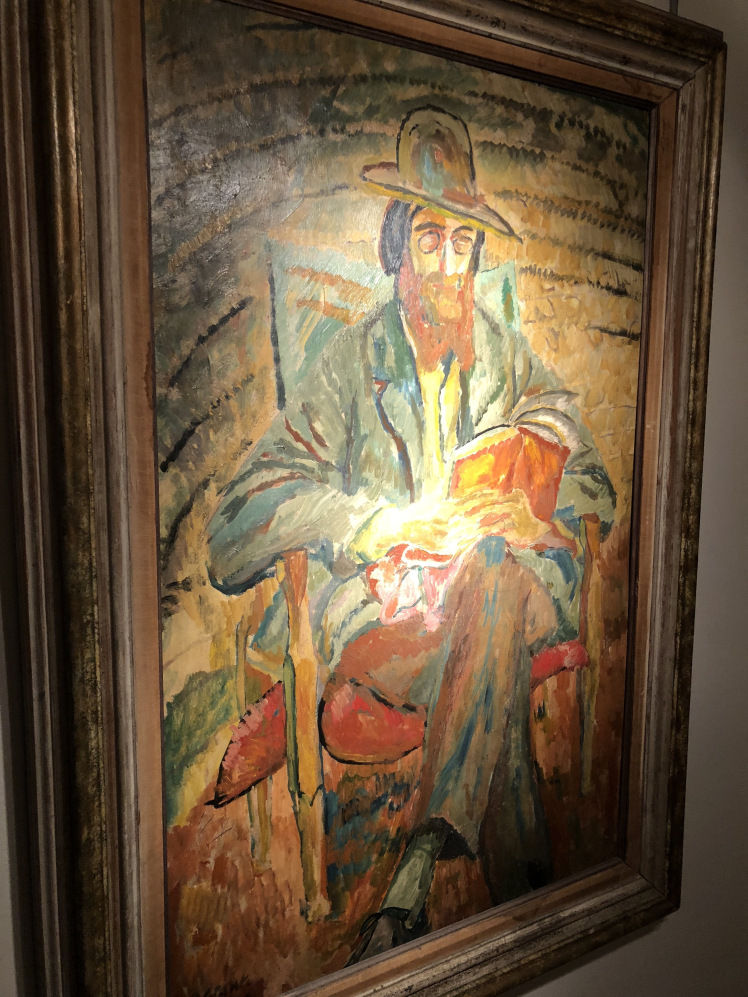
Vanessa Bell’s restless experimentation is on display in a variety of different forms of collage, abstract images and the bold lines of ‘Woman in a Red Hat’ whose cross expression is drawn with confident simplicity.
The more I see of Bell’s work, the more I read about the way she approached life and art, the more impressive she seems. For years, she was secondary to me because I came to her through Woolf. At university, reading ‘To The Lighthouse’ was a revelation: I enjoyed the way it allowed me to become part of the story, to live inside the thoughts and feelings of its characters. It also led to the first time I remember disagreeing with a tutor and the rest of the group, the first time I stuck to a contrary position amongst people that I’d previously been intimidated by.
I kept reading Woolf and remained fascinated by the Bloomsbury set fully aware that many regarded them as figures of fun with their sexual shenanigans and artistic pretensions. For my 20th birthday my friends bought me ‘A Moment’s Liberty,’ the shortened version of Woolf’s diary. I came to know the names, if not the works, of those involved and enjoyed the comings and goings in the squares and triangles of Bloomsbury. Since Lytton Strachey had been a significant figure in Woolf’s life, I read ‘Eminent Victorians’ which quickly became one of my favourite books.
All of which is why I wanted to see the 1999 Tate exhibition ‘the Art of Bloomsbury’ primarily to see depictions of the people I’d been reading about. It marked the beginning of my realisation that other members of the group were worth thinking about. It’s only as a result of googling that exhibition while I was writing this that I’ve discovered how controversial it was, how slated it was by critics at the time, how disliked the artists were for the perceived crimes of pretension, snobbery and celebrating themselves.
I can see why the complicated, bohemian tangled-up love lives, what Andrew Graham Dixon calls the ‘haute-bourgeois soap opera’ often overpowers and annoys the critics. I’m not a critic but I find both Bell and Grant increasingly impressive - particularly Bell - for seeing things differently, for refusing to play by established rules and when marginalised, finding their own way of reframing the debate, their own ways to create art and beauty.
And it’s an art and a way of living that continues to matter. In her notes for the recent Dulwich exhibition of Bell’s work, curator Sarah Milroy wrote,
Unconventional in her approach to both art and life, Bell’s art embodies many of the progressive ideas that we still are grappling with today, expressing new ideas about gender roles, sexuality, personal freedom, pacifism, social and class mores and the open embrace of non-British cultures.
Yes there’s a prurient interest in their unconventional life. Of course some of the many pieces of art they produced were less than perfect. But in their lifelong collaboration, in their unusual relationship Bell and Grant were unceasing in their attempts to reframe the way that we see the world. Can fifty painted plates change the way you see the past, the present and the future? This exhibition makes you think they could.
‘From Omega To Charleston’ continues at Piano Nobile, 129 Portland Road, London W11 4LW until 28 April 2018.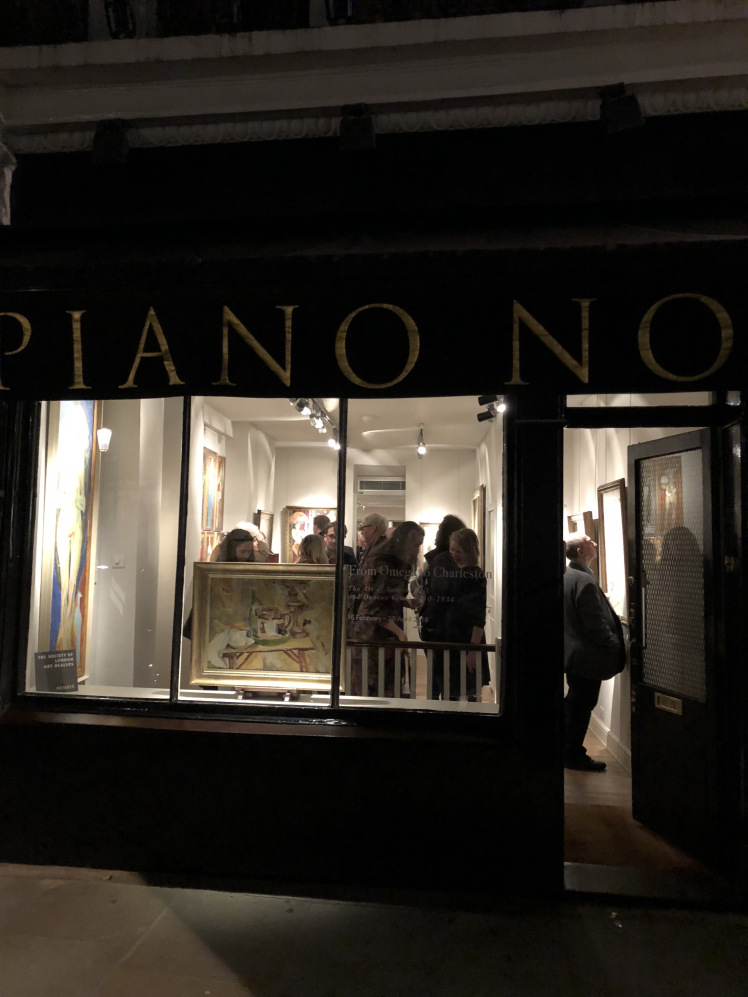 This piece was first published in Wales Arts Review. You can read the original here.
This piece was first published in Wales Arts Review. You can read the original here.